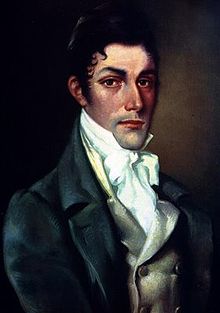Martín de Álzaga
Martín de Álzaga Olabarria (born November 11, 1755 in Ibarra de Aramayona , Álava Province , Spain , † July 1812 in Buenos Aires , Argentina ) was a Spanish businessman and politician at the time of Argentina's independence.
Life
Martín de Álzaga was born in the Basque Country . At a young age he followed his uncle Matéo Ramón de Álzaga, a wealthy overseas trader, to the New World. At first he only spoke Basque. In 1767 he entered the service of Gaspar Santa Coloma's trading house. He later went into business for himself with the trading company "Álzaga y Requena", for which he opened branches in all major American cities.
In 1775 he married Magdalena de la Carrera Inda, with whom he had three sons and ten daughters. In the commercial business he became very wealthy and was considered the richest man in the viceroyalty of the Río de la Plata .
A trip to Spain in 1783 aroused in him the urge to become politically active. In 1785 he was elected to the Cabildo (City Council) of Buenos Aires as defensor de pobres (representative of the poor) . In 1790 he was appointed Procurador . He was one of the founders of the Consulado de Comercio , the Chamber of Commerce of Buenos Aires. He was appointed Alcalde in January 1795. In February there was a shortage of bread in the capital and Álzaga offered the city council the money it needed to buy bread or grain in Montevideo. In September 1796 he asked to be relieved of his public office for health reasons.
It was not until early January 1804 that Alcalde was re-elected. Because of the Napoleonic wars in Europe, the transatlantic leather trade practically came to a standstill. In order to farm his agricultural goods more intensively, he used African slaves .
His military career began unexpectedly when the British occupied Buenos Aires under William Carr Beresford in mid-1806 and Viceroy Rafael de Sobremonte had to flee to Córdoba . Álzaga led together with Cornelio Saavedra militia units of volunteers, with whom it was possible to drive out the English again. As a result, the Cabildo declared viceroy Sobremonte to be deposed and declared Santiago de Liniers the new viceroy. The deposed Sobremonte made Álzaga largely responsible for this uprising.
In 1807 the British, who had initially occupied Montevideo, attacked Buenos Aires again, but were repulsed in a street fight by the local militias under Álzaga and Saavedra.
The internal political situation became more complex in the following years: Napoleonic troops occupied the motherland Spain in 1808 in order to enforce Joseph Bonaparte as king in place of Ferdinand VII , who was in French captivity. Juntas loyal to the king organized the resistance in Spain, and efforts were also made in the colonies in South America to take governance into their own hands. Viceroy Santiago de Liniers lacked legitimacy, on the one hand, because the king was incapable of acting, and on the other hand, he was attacked by the Spanish patriots because of his origins as a potential traitor and friend of the French.
Álzaga stood up for the independence of Argentina; He represented the interests of the Peninsulares , the Spanish-born upper class. The capital's Cabildo Abierto (the meeting of dignitaries) deposed Viceroy Cisneros on May 25, 1810 and appointed a government junta in his place, headed by Cornelio Saavedra.
When Saavedra left at the end of August 1811 to lead the army of the north in the war of independence against the royalist Spaniards, his political opponents around Mariano Moreno used the opportunity to depose the junta; in their place a first triumvirate ruled the province of the Río de la Plata.
Shortly before the triumvirate was scheduled to change in July 1812, a conspiracy by Spanish forces was discovered. The Minister of Finance and War, Bernardino Rivadavia , charged that Álzaga was also one of the conspirators. Martín de Álzaga was arrested, tried, sentenced to death and shot.
A subsequent analysis of the proceedings by the Argentine historian Enrique de Gandía found no evidence of Martín de Álzaga's guilt. For Gandía, the trial of Álzaga was "the greatest crime in Argentine history".
swell
- Biography (spanish)
- Biography (spanish)
- Short biography (Spanish)
Remarks
- ↑ According to other sources: in 1756
| personal data | |
|---|---|
| SURNAME | Álzaga, Martín de |
| ALTERNATIVE NAMES | Álzaga Olabarria, Martín de (full name) |
| BRIEF DESCRIPTION | Spanish merchant and politician at the time of Argentina's independence |
| DATE OF BIRTH | November 11, 1755 |
| PLACE OF BIRTH | Ibarra de Aramayona , Álava Province , Spain |
| DATE OF DEATH | July 1812 |
| Place of death | Buenos Aires , Argentina |
